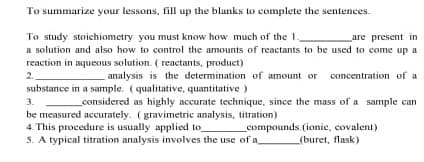To summarize your lessons, fill up the blanks to complete the sentences. To study stoichiometry you must know how much of the 1. a solution and also how to control the amounts of reactants to be used to come up a reaction in aqueous solution. (reactants, product) are present in 2. analysis is the determination of amount or concentration of a substance in a sarmple. (qualitative, quantitative ) 3. _considered as highly accurate technique, since the mass of a sample can be measured accurately. (gravimetric analysis, titration) 4. This procedure is usually applied to S. A typical titration analysis involves the use of a compounds. (ionie, covalent) (buret, flask)
To summarize your lessons, fill up the blanks to complete the sentences. To study stoichiometry you must know how much of the 1. a solution and also how to control the amounts of reactants to be used to come up a reaction in aqueous solution. (reactants, product) are present in 2. analysis is the determination of amount or concentration of a substance in a sarmple. (qualitative, quantitative ) 3. _considered as highly accurate technique, since the mass of a sample can be measured accurately. (gravimetric analysis, titration) 4. This procedure is usually applied to S. A typical titration analysis involves the use of a compounds. (ionie, covalent) (buret, flask)
Chemistry
10th Edition
ISBN:9781305957404
Author:Steven S. Zumdahl, Susan A. Zumdahl, Donald J. DeCoste
Publisher:Steven S. Zumdahl, Susan A. Zumdahl, Donald J. DeCoste
Chapter1: Chemical Foundations
Section: Chapter Questions
Problem 1RQ: Define and explain the differences between the following terms. a. law and theory b. theory and...
Related questions
Question
complete the following sentences

Transcribed Image Text:To summarize your lessons, fill up the blanks to complete the sentences.
To study stoiechiometry you must know how much of the 1
a solution and also how to control the amounts of reactants to be used to come up a
reaction in aqueous solution. ( reactants, product)
2.
substance in a sample. (qualitative, quantitative )
are present in
analysis is the determination of amount or concentration of a
3.
considered as highly accurate technique, since the mass of a sample can
be measured accurately. (gravimetric analysis, titration)
4. This procedure is usually applied to
5. A typical titrntion analysis ivolves the use of a
compounds. (ionie, covalent)
(buret, flask)
Expert Solution
This question has been solved!
Explore an expertly crafted, step-by-step solution for a thorough understanding of key concepts.
Step by step
Solved in 2 steps

Knowledge Booster
Learn more about
Need a deep-dive on the concept behind this application? Look no further. Learn more about this topic, chemistry and related others by exploring similar questions and additional content below.Recommended textbooks for you

Chemistry
Chemistry
ISBN:
9781305957404
Author:
Steven S. Zumdahl, Susan A. Zumdahl, Donald J. DeCoste
Publisher:
Cengage Learning

Chemistry
Chemistry
ISBN:
9781259911156
Author:
Raymond Chang Dr., Jason Overby Professor
Publisher:
McGraw-Hill Education

Principles of Instrumental Analysis
Chemistry
ISBN:
9781305577213
Author:
Douglas A. Skoog, F. James Holler, Stanley R. Crouch
Publisher:
Cengage Learning

Chemistry
Chemistry
ISBN:
9781305957404
Author:
Steven S. Zumdahl, Susan A. Zumdahl, Donald J. DeCoste
Publisher:
Cengage Learning

Chemistry
Chemistry
ISBN:
9781259911156
Author:
Raymond Chang Dr., Jason Overby Professor
Publisher:
McGraw-Hill Education

Principles of Instrumental Analysis
Chemistry
ISBN:
9781305577213
Author:
Douglas A. Skoog, F. James Holler, Stanley R. Crouch
Publisher:
Cengage Learning

Organic Chemistry
Chemistry
ISBN:
9780078021558
Author:
Janice Gorzynski Smith Dr.
Publisher:
McGraw-Hill Education

Chemistry: Principles and Reactions
Chemistry
ISBN:
9781305079373
Author:
William L. Masterton, Cecile N. Hurley
Publisher:
Cengage Learning

Elementary Principles of Chemical Processes, Bind…
Chemistry
ISBN:
9781118431221
Author:
Richard M. Felder, Ronald W. Rousseau, Lisa G. Bullard
Publisher:
WILEY